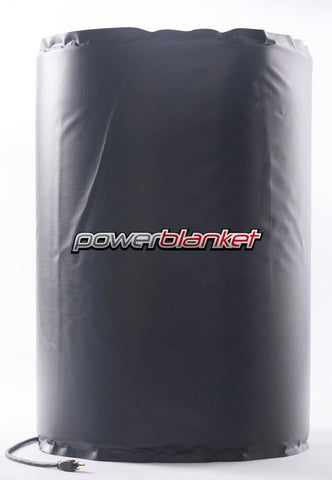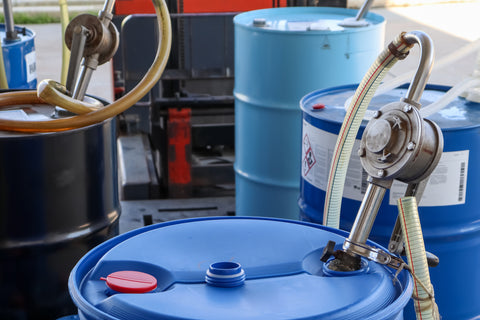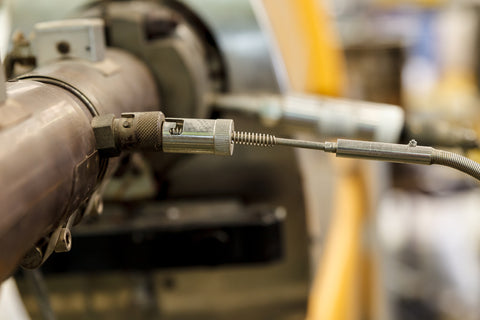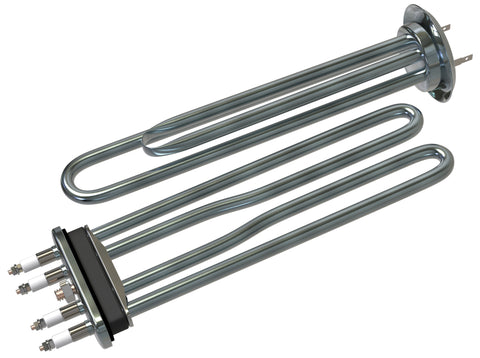The Role of DOT-Approved Drums
DOT-approved drums are specialized containers designed to transport and store hazardous materials safely. A DOT drum must be rigorously tested to meet the Department of Transportation (DOT) standards, ensuring they can withstand the rigors of transportation and prevent leaks or spills. There are two primary types: steel drums and plastic drums, each serving specific needs depending on the hazardous waste being handled.
Steel Drums in the Industry
Steel drums have long been a staple in the hazardous waste industry, valued for their durability and strength. This has kept the steel drum industry going strong as these drums continue to remain in high demand. The most common variety, the 55-gallon drum, is a standard in shipping liquids and solids.
Open-head steel drums are particularly useful for wastes that require frequent access, as they can be securely sealed and reopened as needed. Their robust construction makes them suitable for a wide range of hazardous materials, playing a crucial role in maintaining safety standards.
Industries Relying on Steel Drums
Steel drums are heavily utilized in industries where the strength and integrity of the container are paramount. Key sectors that would choose a steel drum include:

-
Chemical Manufacturing: For storing and transporting various chemicals, especially those that are corrosive or reactive, where the integrity of the container is critical.
-
Oil and Petroleum: Used extensively for transporting petroleum products, oil, and lubricants, where the risk of leakage or contamination needs to be minimized.
-
Pharmaceuticals: In certain situations, steel drums are used to transport bulk pharmaceutical ingredients, especially those that are sensitive to contamination.
-
Hazardous Waste Management: For safely transporting waste that may be reactive or require stringent containment measures.
These industries favor steel for its durability, puncture resistance, and ability to withstand extreme conditions.
Plastic Drums: An Alternative Solution
Plastic drums present an alternative to their steel counterparts, often used for different types of hazardous waste. These drums are lighter, which can reduce shipping costs and are resistant to corrosion, making them ideal for certain chemicals. The versatility of plastic drums, available in various sizes and designs, allows for their adoption in diverse applications within the hazardous waste sector.
Industries Favoring Plastic Drums
Plastic drums are preferred in scenarios where weight and chemical resistance are significant factors. Industries that frequently choose a plastic drum:

-
Agriculture: For storing and transporting pesticides, fertilizers, and other chemicals that require corrosion resistance and lighter containers for easier handling.
-
Food and Beverage: Used for transporting and storing food-grade liquids and solids, benefiting from their lighter weight and good chemical compatibility.
-
Water Treatment: In handling various chemicals used in water treatment processes, such as chlorine and other treatment chemicals, where corrosion resistance is essential.
-
Biomedical and Laboratory Settings: For storing and disposing of certain biohazardous materials or for transporting laboratory chemicals.
In these industries, the corrosion resistance, lighter weight, and versatility of plastic drums make them a more suitable choice, especially when handling materials that are not as physically demanding as those needing steel barrels.
Maintaining Optimal Temperature for Sensitive Materials
In the handling and transportation of temperature-sensitive materials, maintaining the correct temperature is crucial. This is particularly important for certain hazardous materials that may become unstable or lose their properties if not stored at the appropriate temperature. To address this need, DOT-approved drums can be equipped with specialized drum or barrel heaters. These products are designed to maintain a consistent temperature, ensuring the integrity of the material inside. These can be wrapped around a steel drum or a plastic drum without causing concern of breaking down the material.
Drum heaters wrap around the drum and are typically controlled via a thermostat, allowing for precise temperature regulation. This is essential for materials that might freeze in cold conditions or require a certain level of warmth to remain stable. The use of these heaters must be in compliance with DOT regulations, as the safety of transporting hazardous materials can be compromised if the temperature is not properly controlled.
For industries dealing with substances like certain chemicals, pharmaceuticals, or food products, these temperature-controlled solutions are invaluable. They ensure that the materials arrive at their destination in the desired state, avoiding any loss of efficacy or quality due to temperature variations. It is essential, however, that the use of drum heaters is done in accordance with safety guidelines, as improper use could lead to overheating or reactions in the materials being stored.
Compliance with Regulations
Adhering to DOT regulations is vital in the handling of hazardous waste. These regulations define the standards for containers like drums, specifying requirements for durability, design, and safety features. The UN rating, a crucial aspect of these regulations, indicates a drum's suitability for certain types of hazardous materials and their respective packing groups. Complying with these standards ensures that hazardous waste is transported safely, minimizing risks to people and the environment.
The Significance of Packaging and Labels
Proper packaging and labeling are key components of regulatory compliance. Containers must be labeled correctly to indicate the nature of the contents, including hazard symbols and UN ratings. Labels serve as a guide for handlers and emergency responders, providing critical information on the nature of the contents, risks, and handling instructions.
The Manufacturing Process of DOT Drums
The manufacturing of DOT drums is a meticulous process governed by strict DOT requirements to ensure their safety and reliability. These drums are designed with specific materials and constructions to withstand pressure, impacts, and corrosion. They must adhere to DOT-approved standards, including maximum specific gravity and maximum weight limitations, to ensure they can safely contain the hazardous materials.
Testing procedures, such as drop tests, leakproofness tests, and pressure tests, are integral to the manufacturing process. These ensure each drum, whether intended as shipping containers or storage units, meets or exceeds DOT and UN standards, including specific guidelines for packing groups and inner packages. This stringent testing is especially crucial when the drums are used to transport dangerous goods or free liquids, requiring reliable containment under various conditions.
Ensuring Environmental Safety
The Environmental Protection Agency (EPA) plays a significant role in regulating the standards for hazardous waste containers, particularly in overseeing the compliance of DOT-approved drums. By enforcing stringent requirements on the construction and use of these drums, the EPA ensures they effectively prevent leaks and spills.
This oversight is crucial in safeguarding the environment from the dangers of hazardous waste contamination, ensuring that containers used for the transportation and storage of hazardous materials, including dangerous goods and free liquids, meet the necessary safety standards.

Practical Applications and Examples
In practice, DOT-approved drums are used across various industries dealing with hazardous waste. For instance, in the chemical industry, these drums are essential for transporting hazardous liquids, ensuring they are contained safely during transit. Their construction meets the DOT requirements for shipping containers, making them suitable for a variety of dangerous goods.
In the petroleum sector, steel drums are often used to handle petroleum products, thanks to their durability, safety features, and compliance with maximum specific gravity and weight guidelines. This adherence to DOT standards is vital, as it guarantees that the drums can safely contain and transport hazardous materials, playing a pivotal role in industry-wide safety and environmental protection.
Securing Safety and Compliance: The Indispensable Role of DOT-Approved Drums
The importance of DOT-approved drums in the management of hazardous waste cannot be overstated. These containers, whether steel or plastic, play a vital role in ensuring the safe transportation and storage of hazardous materials.
By meeting DOT and UN standards, which include specific requirements for packing groups, inner packages, and maximum weight, these drums provide a reliable solution to a complex challenge. They balance safety, environmental protection, and regulatory compliance, ensuring that industries can safely transport and store hazardous materials, including dangerous goods and free liquids, in accordance with the highest safety standards.
Future Trends in Hazardous Waste Management
Looking ahead, the field of hazardous waste management will continue to evolve with ongoing advancements in container technology and regulatory frameworks. Staying abreast of these changes will be crucial for industries dealing with hazardous materials, ensuring continued compliance and safety in this ever-important field.







